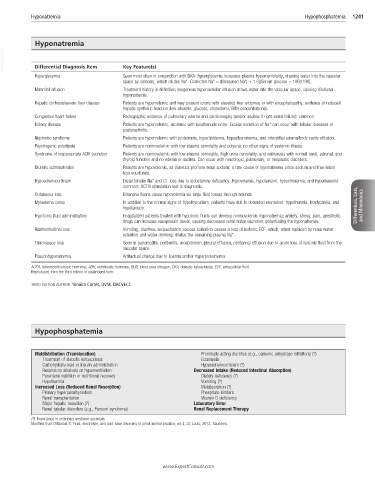Page 2492 - Cote clinical veterinary advisor dogs and cats 4th
P. 2492
Hyponatremia Hypophosphatemia 1241
Hyponatremia
VetBooks.ir Differential Diagnosis Item Key Feature(s)
Hyperglycemia Seen most often in conjunction with DKA: hyperglycemia increases plasma hyperosmolality, drawing water into the vascular
+
space by osmosis, which dilutes Na . Corrected Na = (Measured Na ) + 1.6[(Serum glucose − 100)/100].
+
+
Mannitol infusion Treatment history is definitive; exogenous hyperosmolar infusion draws water into the vascular space, causing dilutional
hyponatremia.
Hepatic cirrhosis/severe liver disease Patients are hypervolemic and may present icteric with elevated liver enzymes or with encephalopathy, evidence of reduced
hepatic synthetic function (low albumin, glucose, cholesterol, BUN concentrations).
Congestive heart failure Radiographic evidence of pulmonary edema and cardiomegaly (and/or ascites if right-sided failure): common
Kidney disease Patients are hypervolemic, azotemic with isosthenuric urine. Excess excretion of Na can occur with tubular diseases or
+
pyelonephritis.
Nephrotic syndrome Patients are hypervolemic with proteinuria, hyperlipidemia, hypoalbuminemia, and interstitial edema/body cavity effusion.
Psychogenic polydipsia Patients are normovolemic with low plasma osmolality and polyuria; no other signs of systemic illness.
Syndrome of inappropriate ADH secretion Patients are normovolemic with low plasma osmolality, high urine osmolality, and natriuresis with normal renal, adrenal, and
thyroid function and no edema or ascites. Can occur with neurologic, pulmonary, or neoplastic disorders.
Diuretic administration Patients are hypovolemic, as diuretics promote renal sodium; a rare cause of hyponatremia since sodium and free water
loss equilibrate.
Hypoadrenocorticism Distal tubular Na and Cl loss due to aldosterone deficiency. Hypovolemia, hypotension, hypochloremia, and hyperkalemia
+
−
common; ACTH stimulation test is diagnostic.
Cutaneous loss Extensive burns cause hypovolemia via large fluid losses through wounds.
Myxedema coma In addition to the normal signs of hypothyroidism, patients have dull to obtunded mentation, hypothermia, bradycardia, and
hypotension. Differentials, Lists, and Mnemonics
Hypotonic fluid administration Hospitalized patients treated with hypotonic fluids can develop normovolemic hyponatremia; anxiety, stress, pain, anesthetic
drugs can increase vasopressin levels, causing decreased renal water excretion, potentiating the hyponatremia.
Gastrointestinal loss Vomiting, diarrhea, sequestration, excess salivation causes a loss of isotonic ECF, which, when replaced by renal water
retention and water drinking, dilutes the remaining plasma Na . +
Third-space loss Seen in pancreatitis, peritonitis, uroabdomen, pleural effusion, peritoneal effusion due to acute loss of isotonic fluid from the
vascular space.
Pseudohyponatremia Artifactual change due to lipemia and/or hyperproteinemia
ACTH, Adrenocorticotropic hormone; ADH, antidiuretic hormone; BUN, blood urea nitrogen; DKA, diabetic ketoacidosis; ECF, extracellular fluid.
Reproduced from the third edition in unabridged form.
THIRD EDITION AUTHOR: Yonáira Cortés, DVM, DACVECC
Hypophosphatemia
Maldistribution (Translocation) Proximally acting diuretics (e.g., carbonic anhydrase inhibitors) (?)
Treatment of diabetic ketoacidosis Eclampsia
Carbohydrate load or insulin administration Hyperadrenocorticism (?)
Respiratory alkalosis or hyperventilation Decreased Intake (Reduced Intestinal Absorption)
Parenteral nutrition or nutritional recovery Dietary deficiency (?)
Hypothermia Vomiting (?)
Increased Loss (Reduced Renal Resorption) Malabsorption (?)
Primary hyperparathyroidism Phosphate binders
Renal transplantation Vitamin D deficiency
Major hepatic resection (?) Laboratory Error
Renal tubular disorders (e.g., Fanconi syndrome) Renal Replacement Therapy
(?), Importance in veterinary medicine uncertain.
Modified from DiBartola S: Fluid, electrolyte, and acid-base disorders in small animal practice, ed 4, St. Louis, 2012, Saunders.
www.ExpertConsult.com

